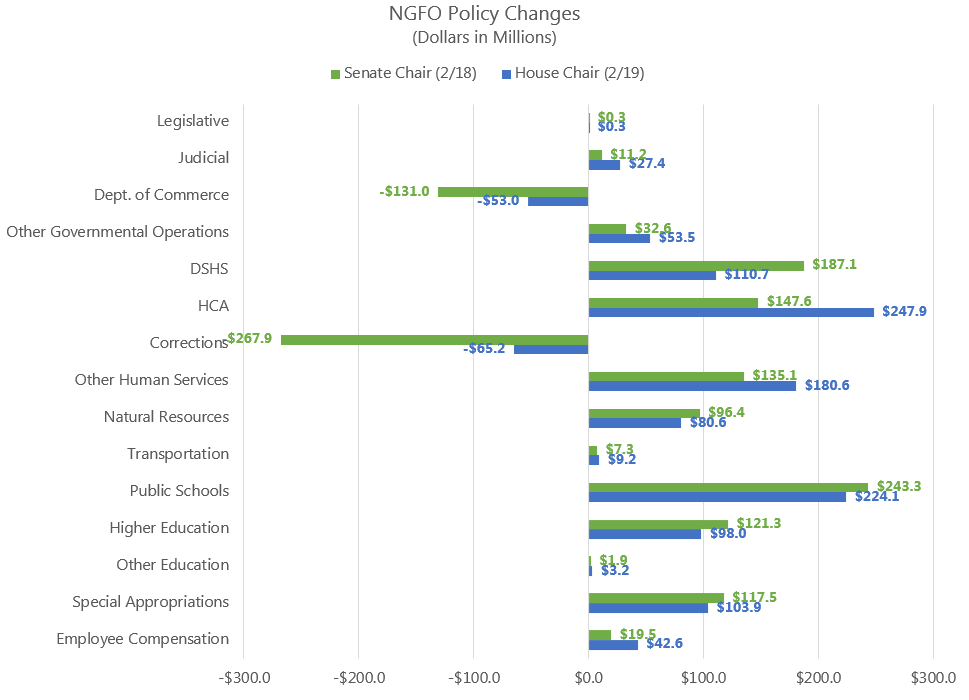10:31 am
February 20, 2024
The Senate chair’s supplemental operating budget proposal would increase 2023–25 appropriations from funds subject to the outlook (NGFO) by $1.854 billion; the House chair’s proposal would increase appropriations by $2.196 billion. Those figures are composed of maintenance level changes (the cost of continuing current services, adjusted for enrollment and inflation) and new policy. (All spending figures in this post are in terms of the NGFO. They do not include funding from the carbon emission allowance auctions—I’ll write about that in another post.)
Both proposals agree on the maintenance level. They estimate that to maintain current services, appropriations will need to increase by $1.132 billion. (Gov. Inslee’s proposal had estimated that the maintenance level changes would be $870.4 million. However, the legislative proposals are based on a newer caseload forecast. Additionally, the governor’s proposal had accounted for the $100.3 million judgment in the Trueblood case and the $94.6 million settlement payouts by the Dept. of Children, Youth, and Families as policy level changes; the legislative proposals include those in maintenance level.)
On top of the maintenance level changes, the Senate chair’s proposal would increase 2023–25 appropriations for new policy by $722.1 million. The House chair’s proposal would increase 2023–25 appropriations for new policy by $1.064 billion. According to the estimated outlooks, the cost of the new policies would increase in 2025–27 by 13.4% in the Senate chair’s proposal and by 27.6% in the House chair’s proposal.
The chart compares the policy changes in the two proposals by budget area.

Dept. of Commerce: The policy changes reduce spending on net because both proposals would transfer solar ($114.0 million) and electric vehicle ($138.0 million) programs to the capital budget. Major increases include:
- Emergency housing and shelter capacity: $55.5 million in the Senate and $49.9 million in the House.
- Local housing programs (document recording fee backfill): $20.0 million in the Senate and $30.0 million in the House.
- Local homeless services: $40.0 million in the House.
Dept. of Social and Health Services (DSHS): Both proposals would save $72.8 million to reflect changes in disproportionate share hospital revenues. Additionally, the House would save $127.1 million by using federal coronavirus state fiscal recovery funds (CSFRF) instead of the NGFO and $29.5 million from development disabilities program underspends. Major increases include:
- Olympic Heritage Behavioral Health operations: $136.0 million in the Senate and $135.0 million in the House.
- Clinical contracted nursing staff at state psychiatric hospitals: $31.2 million in both.
- Forensic beds at the state hospitals: $29.8 million in both.
- Office of Refugee and Immigrant Assistance support services: $5.0 million in the Senate and $25.3 million in the House.
Health Care Authority (HCA): Both proposals book NGFO savings of $40.6 million from the enhanced federal Medicaid match during the pandemic (this ended Dec. 31, 2023). The Senate would save $30.0 million from program integrity activity recoveries from Medicaid managed care plans. Both proposals would save $22.8 million by aligning funding with projected expenditures on long-term civil commitment beds. Major increases include:
- Cannabis revenue distributions: $56.1 million in the Senate and $55.9 million in the House.
- Health care for uninsured adults: $3.5 million in the Senate and $28.2 million in the House.
- Restore program integrity savings that were assumed in the 2023–25 budget but will not be realized: $107.0 million in both.
Dept. of Corrections: Net policy changes are negative because both proposals would use the federal CSFRF in lieu of the NGFO, saving $294.0 million in the Senate and $127.1 million in the House. Additionally, the Senate would recognize $26.4 million in net savings from the closure of Larch Corrections Center; of that, $16.5 million would be reinvested in other correctional facilities.
Public Schools: Both proposals would increase appropriations by $76.9 million to cover the Office of Superintendent of Public Instruction’s “increased allocation of transportation funding to school districts.” On top of that, the Senate proposal would add $19.0 million for pupil transportation (SSB 5873).
The Senate proposal would appropriate $49.6 million to increase staff allocations for paraeducators and others (2SSB 5882). The House proposal would appropriate $43.6 million to increase maintenance, supplies, and operating costs (EHB 2494). (I wrote about both these policies here.)
Both proposals would increase the special education enrollment cap. The Senate would increase it from 15% to 15.6% ($13.5 million) and the House would increase it to 17.25% ($28.5 million).
Other major increases include:
- Community eligibility provision (free school meals): $45.0 million in the Senate and $45.2 million in the House.
- Tribal and charter enrichment: $11.1 million in the Senate ($1,500 per enrollment).
- Small district support: $8.5 million in the Senate and $7.6 million in the House.
Other:
- University of Washington hospitals: $65.0 million in the Senate and $50.0 million in the House.
- UW Behavioral Health Teaching Facility: $20.0 million in both proposals.
- Fire suppression: $27.7 million in both proposals.
- Emergency food assistance: The Senate would shift $26.0 million in funding from the CSFRF to the NGFO. Additionally, funding would increase by $10.0 million in the Senate and by $14.3 million in the House.
- COVID funding shift from the CSFRF to the NGFO: $20.0 million in the Senate and $18.7 million in the House.
- Public health cloud technology: $16.0 million in both proposals.
- State health care affordability account: $15.0 million in both proposals.
- Echo Glen security: $9.0 million in the Senate and $17.9 million in the House.
- PERS and TRS plan 1 benefit increase: $12.6 million the House (a one-time increase of 3%, pursuant to SHB 1985).
Tags: 2024 supp
